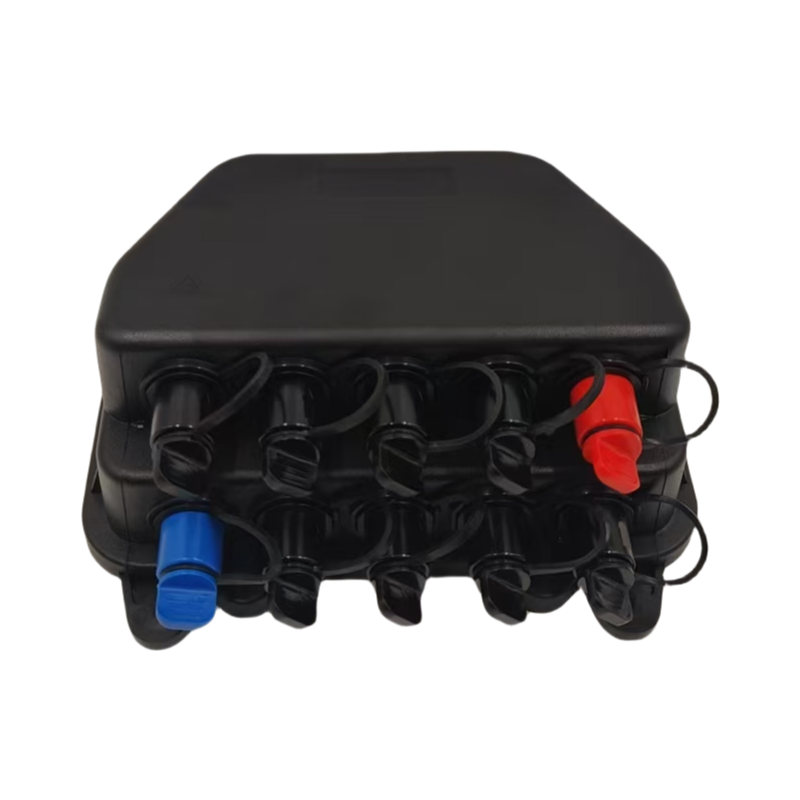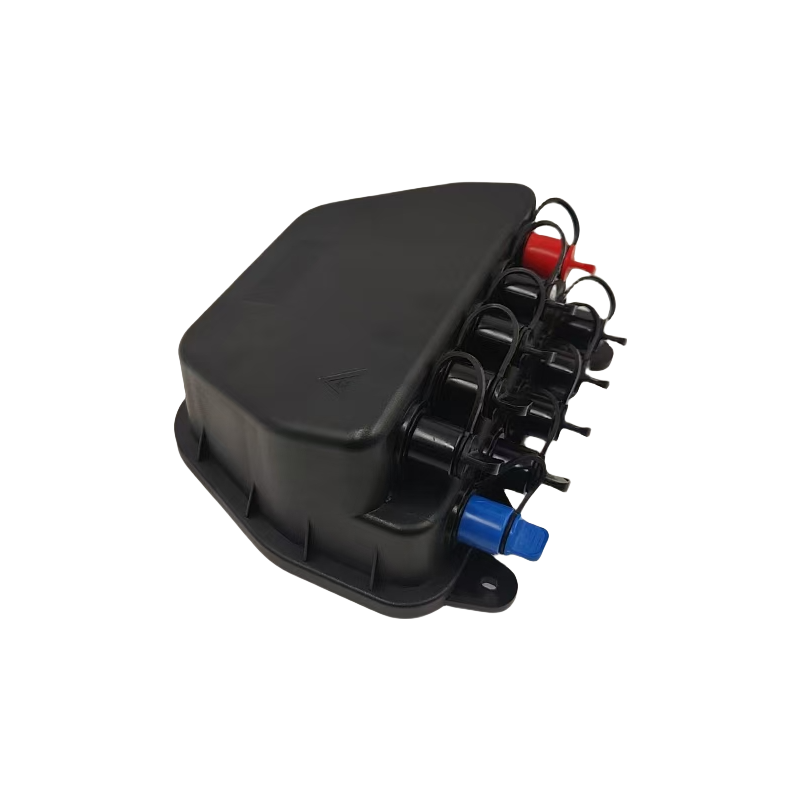Core Components and Functionality of Fiber Optic Boxes
Signal Management in Fiber Distribution Systems
Fiber optic boxes play a fundamental role in signal management by controlling the distribution and routing of light signals to ensure optimal performance. These boxes are designed to handle the flow of data traffic efficiently, directing light signals where needed within a fiber distribution network. This management ensures that signals maintain their strength and quality throughout the network. Splitters and combiners are crucial components in these boxes; they allow the handling of multiple signals by distributing or consolidating them without significant signal loss. The significance of effective signal management is highlighted by data showing that minimizing signal loss is essential for maintaining the integrity and reliability of communications networks. Reliable signal management accommodates the growing demand for bandwidth and ensures that network performance remains consistent, supporting both current and future communication needs.
Protection Features for Optical Connections
Fiber optic boxes incorporate various protections to ensure the longevity and stability of optical connections. Key protection mechanisms include moisture resistance and impact protection, which shield the delicate fibers from environmental and physical damage. Advanced environmental sealing further enhances protection, preventing contaminants from entering the connections. Industry standards such as those from the International Electrotechnical Commission (IEC) guide these protection features, emphasizing the importance of maintaining the endurance and performance of optical systems. Experts agree that these protective features are vital in preventing fiber optic degradation over time, thus ensuring consistent performance and reducing the need for frequent repairs or replacements. The robustness afforded by such features enhances the lifespan of fiber optic boxes, solidifying their role as a durable component within telecommunications.
Scalability in Modular Fiber Enclosures
The modular design of fiber optic boxes offers significant advantages in terms of scalability, allowing for seamless upgrades and network expansion as demand increases. The modularity ensures that additional components can be easily integrated without overhauling the existing infrastructure, providing both economic and operational benefits. This design facilitates cost-effective scalability, enabling organizations to adapt to changes in network demands with minimal disruption. For instance, companies like Verizon and Google have successfully scaled their fiber optic networks by leveraging modular enclosures to meet expanding service areas and customer bases. These examples underscore how scalability through modular design contributes to efficient network management, supporting growth and innovation in fiber optics.
Types of Fiber Optic Boxes in Network Infrastructure
Residential vs. Industrial Splice Enclosures
Residential and industrial splice enclosures differ significantly in design, capacity, and application. Residential splice enclosures are typically designed to cater to household network needs, such as moderate data throughput and straightforward installation and maintenance. Conversely, industrial splice enclosures are tailored for challenging environments, boasting robust designs to withstand harsh conditions, higher capacities to manage substantial data transmission, and advanced features for professional network setups.
1. Design and Capacity: Residential enclosures are compact and efficient for everyday use, while industrial varieties are built for durability and performance under extreme conditions.
2. Key Features: Industrial boxes often include higher-grade materials for enhanced moisture and impact resistance, which makes them preferable for factories or outdoor environments.
Market trends show a steady increase in the utilization of industrial fiber optic boxes due to expanding digital infrastructure demands in manufacturing and outdoor installations.
Outdoor vs. Indoor Termination Units
The design and functionality of outdoor termination units differ significantly from indoor units, primarily due to environmental exposure. Outdoor units are built to withstand challenging weather conditions such as rain, wind, and temperature fluctuations, requiring environmental protection mechanisms like sealing and sturdy materials. In contrast, indoor units are designed for convenience and often feature easy-to-use interfaces suited for indoor network setups.
1. Environmental Protection: Outdoor units offer vital protection against moisture, corrosion, and impact due to their exposure to the elements.
2. Industry Standards: Both types undergo rigorous testing and certification to ensure they meet industry standards, with outdoor units usually subjected to more stringent tests due to their exposure.
Certifications often include IP ratings for water and dust resistance, ensuring the reliability of fiber optic termination units regardless of their installation setting.
Fiber Splitter Boxes for Network Expansion
Fiber splitter boxes play a crucial role in network expansion by allowing multiple connections from a single fiber line. These devices efficiently distribute the light signals, enabling new network branches without a need for additional infrastructure. Due to their high-capacity design, fiber splitter boxes are critical for expanding networks in environments where data traffic is intensive but physical space is limited.
1. Technical Specifications: High throughput and low insertion loss characterize these boxes, making them essential for maintaining data integrity.
2. Network Growth: For example, fiber splitter boxes have facilitated substantial growth in urban network infrastructures, supporting connectivity demands for new residential and commercial developments.
Such boxes have proven indispensable in cases like the rapid development of smart cities, where the demand for efficient and expansive network solutions continually rises.
For more detailed information on these products, explore industrial solutions that cater to specific network enhancement needs.
Installation Best Practices for Fiber Distribution Systems
Cable Routing and Bend Radius Management
Proper cable routing techniques are crucial in fiber optic installations to prevent damage to optical fibers. By avoiding sharp bends, we can maintain fiber integrity and ensure high-quality data transmission. To achieve this, adhering to guidelines that detail the appropriate bend radius is essential, as exceeding this radius risks signal degradation. Industry best practices, such as those specified by the Telecommunications Industry Association (TIA), emphasize the importance of coiling cables gently and minimizing stress points in any installation.
Testing Protocols for Splice Closure Integrity
Testing the integrity of splice closures is a necessity for maintaining a reliable fiber optic system. Various methods, such as Optical Time-Domain Reflectometer (OTDR) testing, play a vital role in identifying faults along the fiber path. Regular testing, ideally at scheduled intervals, helps ensure operational reliability by detecting and rectifying issues promptly. Case studies illustrate that rigorous testing protocols can prevent significant transmission losses and improve overall system performance.
Compliance with Telecommunications Standards
Compliance with telecommunications standards is non-negotiable in fiber optic installations. These standards, such as ANSI/TIA-568, provide guidelines that ensure the reliability and safety of fiber optic boxes. Compliance not only enforces accountability but also guarantees the quality of installations. Organizations like the International Telecommunication Union (ITU) and the Institute of Electrical and Electronics Engineers (IEEE) set these standards to uphold global communication protocols, reflecting their indispensable role in harmonizing industry practices.
Maintenance Strategies for Fiber Termination Units
Real-Time Monitoring of Signal Integrity
Advancements in real-time monitoring technology have revolutionized the way we maintain signal integrity in fiber optics. By employing sophisticated tools such as network analyzers and integrated software systems, we can proactively identify potential issues before they escalate into major disruptions. These technologies enable detailed examination of fiber optic signal paths, alerting us to discrepancies and faults with precision. Moreover, real-time monitoring has proven to significantly reduce downtime and maintenance costs, contributing to a more reliable and cost-effective fiber optic system. In fact, implementing a comprehensive monitoring strategy can lead to a decrease in maintenance expenses by up to 30%, making it a vital component of any effective fiber optic maintenance strategy.
Preventive Cleaning of Connector Ports
Preventive cleaning of connector ports is critical in maintaining the optimal performance of fiber optic systems. Dust, dirt, and debris can accumulate on connectors, leading to signal degradation and added attenuation, which can severely impact data transmission quality. Implementing best practices in cleaning, such as using specialized cleaning kits and solutions designed for optical connectors, ensures that connectors maintain their integrity without incurring damage. It's recommended that preventive cleaning be performed regularly, with frequency tailored to environmental factors such as humidity and dust levels. By adhering to these guidelines, we can ensure consistent signal quality and extend the lifespan of fiber optic components.
Upgrading Legacy Patch Panels
In contemporary fiber optic systems, the continued use of legacy patch panels poses notable risks and drawbacks. These outdated components can lead to signal loss and reduced system reliability. Upgrading to modern patch panels offers substantial benefits, including enhanced performance and improved technological compatibility. Not only do modern panels support higher bandwidth capacities, but they also provide greater resilience against interference and signal degradation. Conducting these upgrades should be scheduled to minimize operational disruption, often advised during planned maintenance windows to leverage new technologies effectively while ensuring seamless integration into existing infrastructure.

Future Innovations in Fiber Connectivity Solutions
AI-Driven Fault Detection in Distribution Nodes
AI technology is revolutionizing how we approach fault detection in fiber optic networks. By leveraging AI's capacity to process large datasets in real-time, these systems can proactively identify potential issues before they manifest. For instance, AI algorithms can monitor network data continuously, spotting anomalies or degradation that precede faults, thus enabling quick responses to prevent downtime. Several organizations have adopted AI-driven fault detection, such as AT&T, which has reported notable improvements in network reliability and reduced maintenance costs. As AI technology advances, we can expect even more sophisticated systems that will transform fiber network management.
Sustainable Materials for Eco-Friendly Boxes
In recent years, there's been a notable shift towards using sustainable materials in constructing fiber optic boxes. This initiative is crucial for reducing the environmental impact of manufacturing and adhering to increasingly stringent regulatory requirements. Eco-friendly materials, such as biodegradable plastics and recycled composites, offer significant benefits, including reduced carbon footprints and enhanced recyclability. Companies are innovating with materials like bioplastics and reclaimed wood composites, which offer durability while being kinder to the environment. These sustainable innovations are becoming a cornerstone in fiber optic solutions, aligning industry practices with broader ecological goals.
5G Integration with Smart Fiber Management
The synergy between 5G technology and fiber optics holds immense potential for enhancing network efficiency. By integrating smart fiber management solutions with 5G infrastructure, network operators can achieve unprecedented performance levels. Key features like automated monitoring and management, real-time traffic optimization, and adaptive bandwidth allocation are vital for seamless 5G integration. For instance, technologies that support dynamic routing and predictive maintenance ensure a robust and agile fiber distribution system, capable of meeting 5G's demands. As these integrations deepen, the result is an efficient and resilient network backbone, ready to support future technological advancements.
FAQ Section
What are the main components of fiber optic boxes?
Fiber optic boxes include components like splitters, combiners, and termination units which are pivotal in managing signal distribution and ensuring optimal performance within networks.
How do fiber optic boxes protect optical connections?
They incorporate moisture resistance, impact protection, and environmental sealing to shield fibers from physical and environmental damage.
Why is scalability important in fiber optic boxes?
Scalability allows for seamless network expansion, enabling organizations to integrate new components without overhauling existing systems, thus supporting growing bandwidth demands efficiently.
What are the differences between outdoor and indoor termination units?
Outdoor units are designed to withstand harsh environmental conditions and require rigorous protection mechanisms, while indoor units prioritize ease of use and are suited for indoor setups.
How do real-time monitoring tools benefit fiber optic systems?
They enable proactive maintenance by identifying issues before they become major disruptions, significantly reducing downtime and maintenance costs.

